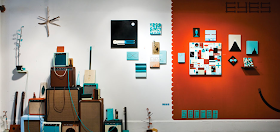George Nelson and Charles and Ray Eames, one of the decisive figures of post-war American design. The focus of his broad oeuvre was on textile design: As head of the Herman Miller Company's textile division, Girard designed a multitude of textiles that reflect his love of festive colours and patterns. He favoured abstract and geometric forms, typically put together in bright constellations of colours. Alexander Girard's upholstery fabrics have lost none of their charm, and a range of classic Girard designs such as Quatrefoil, Names or Toostripe Orange are included in the Vitra and Maharam "Textiles of the 20th century" cushion collection. Having originally studied architecture, Girard made a name for himself over his long career in the fields of furniture, exhibition and interior design as well as in the graphic arts.ts.
Jim Houser









ABOUT
Jim Houser lives and works in Philadelphia, Pennsylvania. Houser's paintings are the system by which he actively catalogs the images and noises which command his attention. His installations create a mapping system, cataloguing the contents of his head over the course of a particular period of time. His interests include: listening to the cadence of speech, science and science fiction, sickness and disease, plants and animals, sport, time travel, ghosts, the art of children, secrets, radio, codes and code breaking, words that sound beautiful and mean something terrible, and words that sound horrible but mean something wonderful. Houser’s paintings are visual poems by which he communicates his innermost thoughts and feelings; words are involved at times, but not in the traditional sense. By cataloging his experiences through a unique pictoral language, the artist has created his own iconography. As a result, the collective imagery acts as a cognitive presentation of highly interpretive ideas. Houser’s signature aesthetic contains elements of stylized figures and hand-drawn typography along with patterned line work—all rendered with clean precision using a gradient of tints and shades within his minimal palette of harmonious flat colors. When his sculptural pieces—which include hand-made guitars and flowerpots—are combined with his paintings, it becomes clear that all of the works are associative and directly related.












































